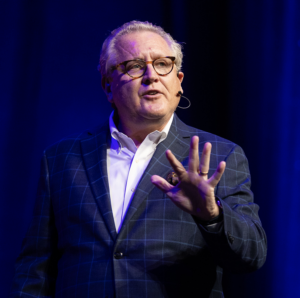
I’ve been giving many talks about community-based marketing, and one of the common discussion points is measurement. Isn’t that ALWAYS the most important question in marketing? What’s the value of a brand community?
But when it comes to community, brands are often entering an alternate universe — many traditional ideas of brand messaging and control are abandoned.
First, let’s be clear that when I say “community,” I mean either building or partnering with an online or offline community who:
- know each other
- gather for a unified purpose
- participate in the direction and evolution of the community
This is different than influencer marketing, which I probably need to address in a separate post. With influencer marketing, you typically lightly touch consumers through a brand mention. Through a community, your aim is to build brand love and loyalty through a consistent effort.
One other caveat — most communities are transactional and focused on customer self-service. The value of those communities is easy to measure because you can track customer service costs and cost avoidance. But a community aimed at customer loyalty and brand-building is harder to quantify.
How do we measure the value of a brand community? Here are ten ideas.
The value of a brand community
As a marketing professional, your ultimate goal is to create customers. There are two ways to do this, either through transactions or brand-building.
Direct transactions (sales) are usually troublesome in a community. People want to be there because they share some purpose with you. They want to grow, learn, and change the world with your help. Of course opportunities to sell are possible, but if all you do is sell, people will run away and never come back.
So, most unrealized benefits from a community come from brand-building. Here are some best practices I’ve observed as companies measure the value of a brand community.
1. Engagement
One of the largest and most successful brand communities in the world is hosted by Sephora. With 6 million members, 80% of the company’s revenues come through this community! But their most important metric is engagement. Nike measures success through user engagement in workout sessions, challenges, and community discussions.
If people are engaging in the community through comments and conversations, it shows the company and the community is relevant. And if they are relevant, their brand is heading in the right direction — a leading indicator of new product success and sales.
In the social media world, I’m not a fan of using engagement as a primary metric. But when it comes to community, engagement is highly prized.
2. Ideas and innovations
Many brand communities put a premium on ideas for new products and innovations. For example, IKEA, Nike, and Lego all run large communities devoted to product development. Community members have a stake in the success of these products, which drives loyalty and sales.
3. Advocacy
Research shows that trust in businesses, media, and advertising is at an all-time low. But we trust in each other. In fact, word-of-mouth recommendations and user-generated content drive a large portion of sales these days.
Using a community to drive UGC beyond the community is massively valuable for any brand, and it is fairly easy to measure.
4. Conversion Metrics
Tracking metrics such as conversion rates, customer lifetime value (CLV), and the correlation between community engagement and product purchases helps measure the transition from community member to customer.
5. Brand Sentiment
Closely related to engagement rate is sentiment. Are the brand-related conversations positive? Positive sentiment indicates a strong and healthy community that can drive UGC and loyalty. New AI tools are allowing communities to assess thousands of data points to gauge conversations.
6. Growth of Community
Measuring the number of members joining the community over a specific period is a reflection of relevance and a leading indicator of sales.
7. Brand relevance
A primary value of a brand community is the dialogue between you and your customer. A successful brand has to be a journey of relentless relevance and there is no better way to do that than to let your customers lead you to what is next.
The ideas shared in my community help me be a more relevant and effective speaker, writer, and consultant. This is the primary benefit of my community — not just to me but to all of us.
It’s hard to pin a specific dashboard measurement on this one, but it’s an important qualitative measure of success.
8. Customer Loyalty and Purchase Behavior
Some brand communities are using sophisticated tools to measure:
- Loyalty
- Purchase behaviors versus non-community members
- Referrals
- Affiliate sales
- Churn and retention rates
9. Information flow
This would go as a measure of the PR value of a community.
A value of a brand community is the unprecedented speed of information flow — in both directions. You don’t have to wait to gather a consumer panel if you want to test an idea quickly. Throw it out to the community.
Is there a rumor or problem with misinformation? You can address this immediately in a community and that can influence perception and subsequent coverage.
In a world of misinformation, a community is a place to find the truth and stop rumors.
10. Sales
Ultimately, we need to create buying customers, or we will go out of business. However, I’ve interviewed dozens of community leaders, and none of them claim sales are their primary goal. It can’t be. People are tired of being sold to. The focus has to be on the shared purpose between brand and community, which leads to commitment and loyalty.
Loyalty leads to sales, and when done right, community will certainly fuel your bottom line.
I hope these ideas help. I’ve been consulting and speaking extensively on brand community strategy, so let me know if you have further questions or ways I can help you.
 Need a keynote speaker? Mark Schaefer is the most trusted voice in marketing. Your conference guests will buzz about his insights long after your event! Mark is the author of some of the world’s bestselling marketing books, a college educator, and an advisor to many of the world’s largest brands. Contact Mark to have him bring a fun, meaningful, and memorable presentation to your company event or conference.
Need a keynote speaker? Mark Schaefer is the most trusted voice in marketing. Your conference guests will buzz about his insights long after your event! Mark is the author of some of the world’s bestselling marketing books, a college educator, and an advisor to many of the world’s largest brands. Contact Mark to have him bring a fun, meaningful, and memorable presentation to your company event or conference.
Follow Mark on Twitter, LinkedIn, YouTube, and Instagram
Image courtesy Midjourney


